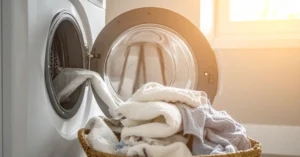Many homeowners wonder if they can safely use a dishwasher with a septic tank. The good news is that you absolutely can have a dishwasher with a septic tank, but you need to follow some important rules to keep both working well together. Understanding how these systems interact will help you avoid costly problems and enjoy clean dishes without damaging your septic system.
How Septic Tanks Work with Kitchen Appliances
Your septic tank is like a underground treatment plant that breaks down waste from your home. When you use a dishwasher with a septic tank, all the water and soap from washing dishes goes into this system. The tank uses helpful bacteria to eat away at solid waste and filter water before it goes into your yard’s drain field.
The key to making a dishwasher with a septic tank work properly is understanding that your septic system needs balance. Too much water at once can overwhelm the system, and harsh chemicals can kill the good bacteria that keep everything working smoothly. This is why it’s crucial to choose the right detergents and use your dishwasher wisely.
Choose the Right Detergent for Your Dishwasher with a Septic Tank
The type of soap you use in your dishwasher with a septic tank makes a huge difference. Many regular dishwasher detergents contain phosphates and antibacterial chemicals that can harm your septic system. These chemicals kill the helpful bacteria in your tank that break down waste.
Look for detergents labeled as “septic-safe,” “biodegradable,” or “phosphate-free” when shopping for your dishwasher with a septic tank. These products won’t hurt the bacteria in your system. Some good options include powder detergents that dissolve completely and don’t leave residue. Always read the label to make sure it says it’s safe for septic systems.
According to the Environmental Protection Agency, harsh chemicals and antibacterial products can disrupt the natural bacterial balance needed for proper waste treatment. This is why choosing the right detergent is so important for your dishwasher with a septic tank setup.
Water Usage and Timing Tips
Modern dishwashers use about 3 to 5 gallons of water per load, which is actually less than washing dishes by hand. However, when you have a dishwasher with a septic tank, you still need to be smart about when and how often you run it.
Don’t run your dishwasher at the same time as your washing machine or when someone is taking a long shower. This puts too much water into your septic system at once. Spread out your water use throughout the day to give your system time to process everything properly.
Try to run your dishwasher with a septic tank only when it’s full. This saves water and reduces how often you need to use it. If you have a small family, you might only need to run it every other day or a few times a week.
Proper Loading and Pre-Cleaning
How you load your dishwasher with a septic tank affects your system’s health. Always scrape off large food pieces before loading dishes, but don’t over-rinse them. Too much food waste can clog your septic system, while too much water from rinsing can overwhelm it.
Remove bones, fruit pits, and other hard items that won’t break down easily. These can cause problems in your septic tank or drain cleaning needs. Some dishwashers have built-in food disposal systems, which can help reduce the amount of solid waste going into your septic tank.
Never put grease or oil down your kitchen drain or in your dishwasher with a septic tank. Grease hardens in your pipes and can cause serious plumbing problems. Wipe greasy dishes with a paper towel first, then load them normally.
Maintenance Schedule for Dishwasher with a Septic Tank
Regular maintenance keeps your dishwasher with a septic tank working properly for years. Clean your dishwasher’s filter monthly to prevent clogs and bad smells. Check for leaks around the connections, as extra water can overload your septic system.
Your septic tank needs pumping every 3 to 5 years, according to EPA guidelines. If you use your dishwasher with a septic tank frequently, you might need pumping slightly more often. Keep track of your usage and watch for warning signs like slow drains or bad smells.
Consider signing up for The Solid Care Plan to stay on top of your septic system maintenance. Regular inspections can catch problems early and save you money on major repairs.
Signs Your Dishwasher with a Septic Tank Needs Attention
Watch for warning signs that your dishwasher with a septic tank setup needs help. Slow draining in your kitchen sink, bad smells near your dishwasher, or water backing up are all red flags. These problems often start small but can become expensive if ignored.
If your dishwasher leaves spots on dishes or doesn’t clean well, it might be using too much detergent or the wrong kind. Too much soap creates extra suds that can stress your septic system. If you notice gurgling sounds when your dishwasher drains, this could mean a blockage somewhere in the system.
Green or soggy areas in your yard near the septic drain field can signal that your system is overloaded. This sometimes happens when a dishwasher with a septic tank isn’t balanced properly with other water use in your home.
What NOT to Do with Your Dishwasher with a Septic Tank
Avoid several common mistakes when you have a dishwasher with a septic tank. Never use regular household bleach or antibacterial cleaners in your dishwasher. These products kill the helpful bacteria your septic tank needs to work properly.
Don’t put non-food items like napkins, plastic wrap, or aluminum foil in your dishwasher with a septic tank. These materials won’t break down and can clog your system. Even small pieces can cause big problems over time.
Resist the urge to use your garbage disposal frequently if you have a dishwasher with a septic tank. The combination puts extra solid waste into your system that takes longer to break down. Instead, scrape food into the trash before washing dishes.
Energy-Efficient Models Work Better
Newer, energy-efficient dishwashers work better with septic tanks than older models. These machines use less water per load and have better filtration systems. Energy Star certified dishwashers can use 35% less energy and 50% less water than standard models.
If you’re shopping for a new dishwasher with a septic tank in mind, look for models with soil sensors. These automatically adjust water use based on how dirty your dishes are. Some also have eco-wash settings that use even less water for lightly soiled loads.
Consider a dishwasher with a septic tank that has a built-in food disposal system. These help break down small food particles before they enter your septic system, reducing the load on your tank.
Professional Help When You Need It
Sometimes your dishwasher with a septic tank setup needs professional attention. If you experience emergency plumbing issues like sewage backups or complete drainage failure, don’t try to fix it yourself.
Professional plumbers can inspect both your dishwasher connections and septic system to find problems. They can also recommend the best detergents and usage patterns for your specific setup. Regular camera line inspections can spot developing issues before they become expensive repairs.
If you’re installing a new dishwasher with a septic tank, have a professional check that your system can handle the extra water load. Some older septic systems might need upgrades to work well with modern appliances.
Benefits of Using a Dishwasher with a Septic Tank
When done right, having a dishwasher with a septic tank actually offers several benefits. Modern dishwashers use less water than washing dishes by hand, which is better for your septic system. They also heat water to higher temperatures than most people use when hand washing, which kills more germs.
A properly maintained dishwasher with a septic tank setup saves time and reduces the amount of grease and food particles that might go down your drain from hand washing. This can actually help extend the life of your septic system when combined with good habits.
Energy-efficient dishwashers also save money on water and electric bills while being gentler on your septic system than older models. The consistent water usage patterns from a dishwasher can be easier for your septic system to handle than the variable flow from hand washing.
Long-Term Care for Your System
Taking good care of your dishwasher with a septic tank requires thinking about long-term health, not just daily use. Keep records of when you pump your septic tank, what detergents you use, and any problems you notice. This information helps when you need professional service.
Consider having your septic system inspected yearly if you use a dishwasher with a septic tank regularly. Early detection of problems saves money and prevents environmental damage. Many maintenance plans include these inspections along with other plumbing services.
Plan ahead for eventual septic system replacement or major repairs. Most septic systems last 20-30 years with proper care, but heavy use from appliances like dishwashers might shorten this timespan slightly. Setting aside money for future maintenance helps avoid emergency expenses.
Making the Right Choice for Your Home
Deciding whether to install a dishwasher with a septic tank depends on your specific situation. Consider your family size, current water usage, and the age and condition of your septic system. Smaller households with newer septic systems typically have fewer problems than large families with older tanks.
If you’re unsure whether your septic system can handle a dishwasher, have a professional evaluation done first. They can test your system’s capacity and recommend any upgrades needed. This upfront investment prevents costly problems later.
For many San Diego County homeowners, having a dishwasher with a septic tank works well with proper planning and maintenance. The convenience and water savings often outweigh the extra care needed to keep both systems working together.
Remember that every septic system is different, and what works for your neighbor might not work for your home. When in doubt, consult with experienced professionals who understand both dishwashers and septic systems. Contact us today for personalized advice about your specific setup and maintenance needs.



